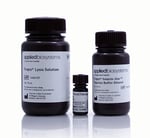Learn More
Invitrogen™ Galacto-Star™ β-Galactosidase Reporter Gene Assay System for Mammalian Cells
Description
Includes
Lysis solution, substrate, enhancer, and required buffer
- Glow assay kinetics provides a window during which measurements may be performed, facilitating HTS applications where assay automation is used
- Can be used with either mammalian or yeast model systems, providing flexibility in choice of model systems
- Wide dynamic range of β-galactosidase assay lets the user measure enzyme level accurately from femtogram to nanogram range
- Assay sensitivity is 100- to 1,000-fold better than either the isotopic/non-isotopic assays for chloramphenicol acetyl transferase (CAT) or the colorimetric/fluorescent assays for β-galactosidase, providing greater sensitivity than competing assays
- Highly sensitive assay with a wide dynamic range permits detection of high and low levels of reporter without performing numerous sample dilutions
- Non-radioactive reporter gene assay kit eliminates concerns over use of radioisotopes
- Assay can be completed in about one hour, providing fast assay turnaround
Sensitive
The chemiluminescent assay exhibits over three orders of magnitude greater sensitivity than colorimetric β-galactosidase assays and can be completed in a fraction of the time required for assays for chloramphenicol acetyltransferase (CAT) and ELISA-based reporter assays.
Versatile
The Galacto-Star system includes Galacton-Star chemiluminescent substrate for β-galactosidase and is suited for measurement in both luminometers and scintillation counters. Automatic injection is not required.
Long-Lasting Signal
Light emission from the Galacto-Star assay reaches maximum in 60 to 90 minutes and remains constant for nearly one hour. Cell lysate is mixed with reaction buffer containing Galacton-Star substrate and Sapphire-II™ luminescence enhancer. After a 60-90 minute incubation at room temperature, the signal is measured in a luminometer or scintillation counter.
Specifications
- Assay Type: β-Gal (lacZ) Assay
- Compatible Cells: Mammalian Cells
- Detection Method: Chemiluminescent
- For Use With Equipment: Luminometer (Microplate)
- Form: Liquid
- Format: 96-well plate
- High Throughput Compatibility: High Throughput-Compatible
- Readout: End Point
- Sample Type (Specific): Cell Cultures
- Substrate: Galacton-Star
- Substrate Properties: Chemical Substrate
- Substrate Type: Beta-Gal Substrate
- Target Enzyme: Beta-Galactosidase

Specifications
Specifications
| Product Type | β-Galactosidase Reporter Gene Assay System |
| Detection Method | Chemiluminescence |
| For Use With (Equipment) | Luminometer (Microplate) |
| Assay | β-Gal (lacZ) Assay |
| Content And Storage | This kit contains the lysis solution, substrate, enhancer, and required buffer. Store the product at 4°C. |
| Compatible Cells | Mammalian Cells |
| High-throughput Compatibility | High-throughput Compatible |
| Label or Dye | Unconjugated |
| Readout | End Point |
| Sample Type | Cell Cultures |
| Show More |
For Research Use Only. Not for use in diagnostic procedures.
Your input is important to us. Please complete this form to provide feedback related to the content on this product.




